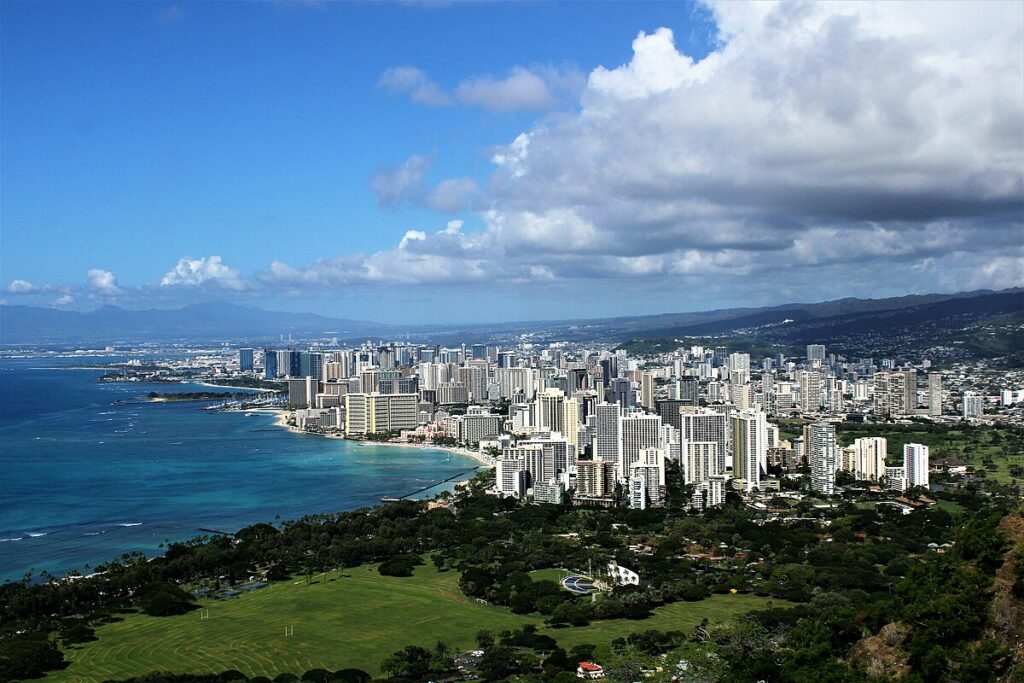
Moving to Honolulu, Hawaii: A Comprehensive Relocation Guide
Considering moving to Honolulu, Hawaii? This vibrant state capital offers Waikiki beaches, urban energy, and island paradise. With approximately 350,000 residents in 2025 (metro 1 million+), Honolulu combines city sophistication with tropical beauty and Hawaii’s premier metropolitan destination.
Demographic Profile to Consider If Moving to Honolulu:
Honolulu’s 2025 city population is approximately 350,000 residents, with the Oahu metro exceeding 1 million (nearly 70% of Hawaii’s population). The median age is around 39 years, with diverse residents including Native Hawaiians, Asian Americans (largest group), military families, professionals, and international residents. The population is approximately 43% Asian, 19% White, 18% Two or More Races, 9% Native Hawaiian and Pacific Islander, 8% Hispanic. Honolulu features Waikiki’s resort hotels and beaches, downtown’s business district, diverse neighborhoods from Manoa to Kaimuki to Hawaii Kai, and urban density rare in Hawaii. As state capital and economic center, Honolulu attracts professionals, military personnel, and those seeking city amenities with island setting. The community balances tourism with residential life, modern development with Hawaiian culture, and urban density with aloha spirit. Find trusted local services for moving, living, and working in Honolulu.Honolulu Relocation Directory
Cost of Living to Consider If Moving to Honolulu:
Honolulu ranks among America’s most expensive cities. Median home values range from $750,000 to $1.2 million+ in 2025, with beachfront and desirable neighborhoods commanding significantly more. The median household income is approximately $85,000. Rental properties average $2,500 to $4,000+ monthly. Hawaii has high excise tax (4.5%). Overall cost of living is extremely high—groceries cost 50-80% above mainland, gas is expensive, utilities are costly, and everything costs more due to shipping. Honolulu attracts military families (BAH helps), high-earning professionals, and those willing to pay premium for paradise. Housing costs create significant barriers though diverse neighborhoods offer range. The extreme expense requires careful financial planning and often dual incomes or military/government employment providing cost-of-living adjustments.
Economy and Job Market:
Honolulu’s economy centers on tourism, military, government, healthcare, and professional services. Major employers include the U.S. military (Joint Base Pearl Harbor-Hickam, Schofield Barracks, others), State of Hawaii government, City and County of Honolulu, hospitals including Queens Medical Center and Kaiser Permanente, University of Hawaii at Manoa, and hotels throughout Waikiki. Tourism dominates employment. Professional services thrive downtown. The Port of Honolulu handles cargo. Typical industries include tourism, military, government, healthcare, education, and professional services. The economy provides diverse opportunities though many positions require island-specific experience. Military employment provides stability. High costs mean many residents work multiple jobs.
Education:
Hawaii Department of Education operates public schools throughout Honolulu with varied quality. Schools including Roosevelt High School, McKinley High School, and others serve neighborhoods. Private schools including Punahou School, Iolani School, and Mid-Pacific Institute are popular with families who can afford tuition. The University of Hawaii at Manoa is the state’s flagship university offering comprehensive programs. Chaminade University and Hawaii Pacific University provide additional options. The educational infrastructure reflects urban scale with choice requiring research or tuition.
Recreation and Lifestyle:
Honolulu offers world-famous Waikiki Beach, Diamond Head crater hike with panoramic views, Pearl Harbor historic sites (USS Arizona Memorial, Battleship Missouri, USS Bowfin), Hanauma Bay for snorkeling, numerous beaches from Ala Moana to Lanikai to Waimanalo, hiking trails throughout the island, and year-round ocean activities. Residents enjoy Ala Moana Center (largest open-air mall), downtown’s Chinatown with galleries and nightlife, restaurants serving diverse Pacific Rim cuisine, and cultural venues. Professional sports include University of Hawaii football and basketball. The North Shore’s legendary surf breaks are accessible. The lifestyle combines urban conveniences with beach access, diverse dining, multicultural influences, and aloha spirit. The tropical climate enables perpetual outdoor living. The community values diversity, respect for Hawaiian culture (though tourism impacts authenticity), ocean connection, and island ohana despite urban density. Living in Honolulu means accepting extreme costs, traffic congestion (H-1 freeway notorious), tourist crowds in Waikiki, and trading space for paradise. The city offers Hawaii’s most career opportunities and urban amenities while maintaining island beauty.
Healthcare and Services:
Honolulu residents access world-class healthcare through Queens Medical Center, Kaiser Permanente facilities, Straub Medical Center, Tripler Army Medical Center (military), and extensive medical infrastructure. The healthcare system serves as Hawaii’s medical hub with specialized care in all disciplines.
Transportation:
Daniel K. Inouye International Airport (HNL) provides extensive mainland and international flights. TheBus operates comprehensive routes throughout Oahu with excellent coverage. The Skyline rail system began limited operations with expansion ongoing. Most residents require personal vehicles though some manage car-free in urban Honolulu. Traffic congestion is significant during rush hours. Gas is very expensive. Typical commute times range 30-60 minutes. Some neighborhoods offer walkability.
Conclusion:
Moving to Honolulu in 2025 offers urban island living with Waikiki beaches, diverse culture, and career opportunities. The city’s combination of Diamond Head views, professional employment, and tropical paradise makes it ideal for military families, career professionals, and those seeking Hawaii’s metropolitan center where city sophistication meets island aloha and extreme costs buy life in America’s Pacific paradise capital.

